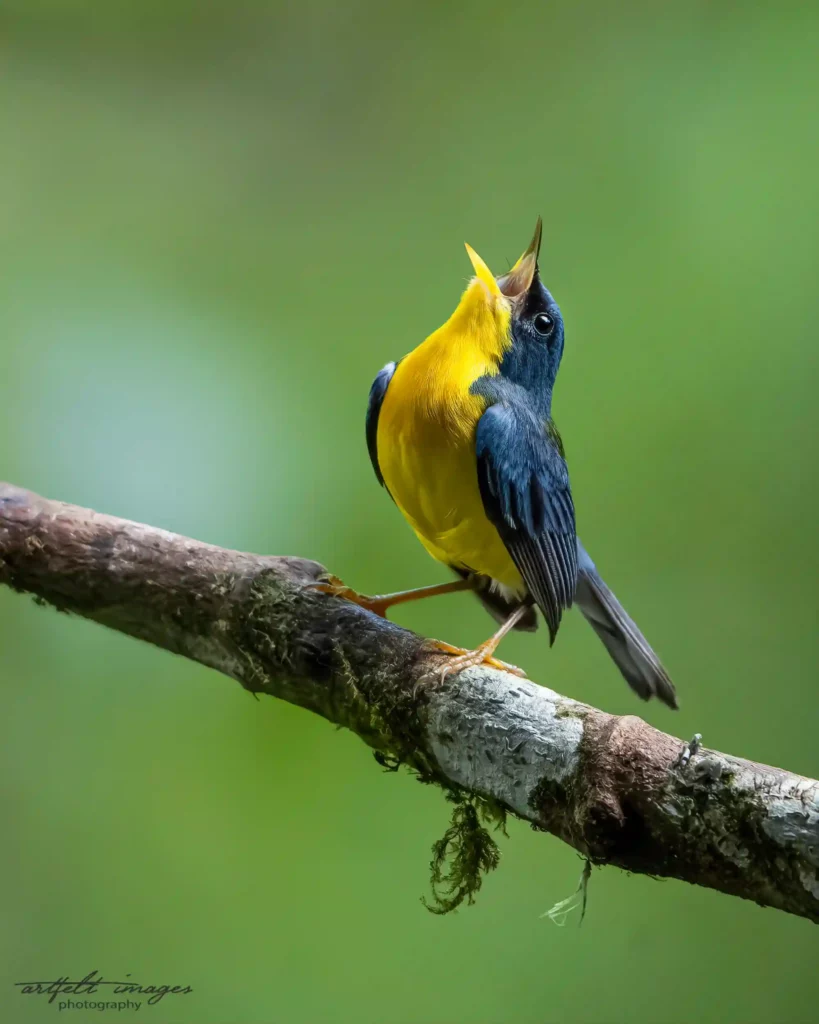Tropical Parula
The Tropical Parula is a small, vibrant warbler known for its energetic movements and striking coloration. Found from southern Texas through Central America to northern Argentina, this species is a delightful sight for birdwatchers, especially in the montane forests of Costa Rica.

Setophaga pitiayumi
Scientific Name
Parulidae (New World Warblers)
Family
Passeriformes
Order
S. p. inornata
Subspecies. Costa Rica
Range and Habitat of Tropical Parula
Geographic Range
The Tropical Parula’s range extends from southern Texas and northwest Mexico through Central America to northern Argentina, including Trinidad and Tobago.
Migratory Patterns
Generally non-migratory, though some northern populations may make local movements.
Preferred Habitat
Prefers hills and premontane forests, often in moderately disturbed and secondary forests, showing resilience in fragmented habitats.
Altitude Range
In Costa Rica, found from 600 to 1,850 meters on the Caribbean slope and above 900 meters on the Pacific side.
Costa Rica Habitat
In Costa Rica, the Tropical Parula is commonly observed in tall wet highland forests, taller trees in adjacent clearings, and secondary growth.
Conservation Status
Least Concern
Conservation Status
Population Status
The Tropical Parula is currently classified as Least Concern by the IUCN, with an estimated population of 20 million mature individuals.
Habitat loss due to deforestation and human encroachment poses the most significant threat to the Tropical Parula.
Conservation efforts
Conservation efforts focus on preserving natural habitats and protecting forested areas, which are crucial for the species' survival.
Primary Threats
Habitat loss due to deforestation and human encroachment poses the most significant threat to the Tropical Parula.
Tropical Parula Identification
How to Identify the Species
Rarity Level:
CommonBest Viewing Times:
Early Morning (Dawn - 8 AM), Afternoon (2 PM - 5 PM)
Size
Approximately 11 cm (4.3 inches)
Plumage
Males exhibit blue-gray upperparts with a greenish back patch, two white wing bars, and intense yellow-orange underparts. Females are slightly duller and lack the black facial markings.
Distinctive Features
Short, stout bill adapted for insect consumption; vibrant coloration in males; subtle hues in females.
Sexual Dimorphism
Males and females have distinct plumage, with males displaying more vivid colors compared to the more subdued tones of females.
Diet and Feeding Behavior
Primary Diet
- Primarily insectivorous, feeding on small arthropods, mostly insects, and occasionally plant material.
Foraging Techniques
- Forages actively from mid-level to the treetops, frequently along streams. Searches among leaves, hovers momentarily to take insects from foliage, and sometimes flies out to catch flying insects in mid-air.
Feeding Times
- Active during daylight hours, with peak feeding activity in the morning and late afternoon.
Behavior Patterns
Tropical Parula
Social Structure
Typically observed alone or in pairs; not known to form large groups.
Song and Vocalization
Emits a high buzzy trill, and the call is a sharp “tsit.”
Courtship and Mating Ritual
Males may perform displays and vocalizations to attract females; both sexes participate in nest building.
Territoriality
Territorial during the breeding season, with pairs defending nesting sites from intruders.
Birdwatching Tips
Best Locations for Spotting Tropical Parula
In Costa Rica, prime locations include the Caribbean foothills and montane forests, particularly areas rich in epiphytes.

Best Time of the Year
Year-round, with increased visibility during the dry season (December to April).
Common Behavior
Look for individuals flitting through the forest canopies, especially during early morning hours.
Recommended Gear
Binoculars with good resolution, a camera with a zoom lens, and a field guide for identification.
Breeding and Nesting Behavior
Breeding Season
In Costa Rica, the Tropical Parula breeds mostly during the dry and early rainy season, typically from March to June.
Nesting Sites
The female builds a domed or globular nest with a side entrance, usually located in bromeliads, ferns, or mossy branches, often high in the forest canopy (3 to 15 meters above ground).
Clutch Size
Typically lays 2 to 4 eggs, white to cream-colored with fine reddish or brown speckles.
Incubation Period
Only the female incubates the eggs for about 12–14 days while the male guards the territory and may feed the female occasionally.
Parental Care
Both parents feed the chicks, mostly with small insects, caterpillars, and spiders. Young birds fledge around 10–12 days after hatching, but continue to receive care from both adults for several more days.
Did You Know?
Common but fast-moving
The Tropical Parula is widespread and easy to hear, but often hard to photograph—constantly flitting among mid and upper canopy branches.
Two-toned song
Males sing a clear, high-pitched trill often described as “tsip-tsip-tsip-tsreee,” which is used to mark territory during the breeding season.
Bright and compact
Easily recognized by its deep blue upperparts, bright yellow throat and chest, and white belly. A small chestnut patch may be visible on its back, especially in males.
Edge and forest species
Found in humid lowland and montane forests, but also in forest edges, coffee plantations, and gardens—especially where epiphytes are abundant.
Resident species
Non-migratory in Costa Rica; maintains territories year-round and is often seen alone or in pairs, sometimes joining mixed-species flocks.